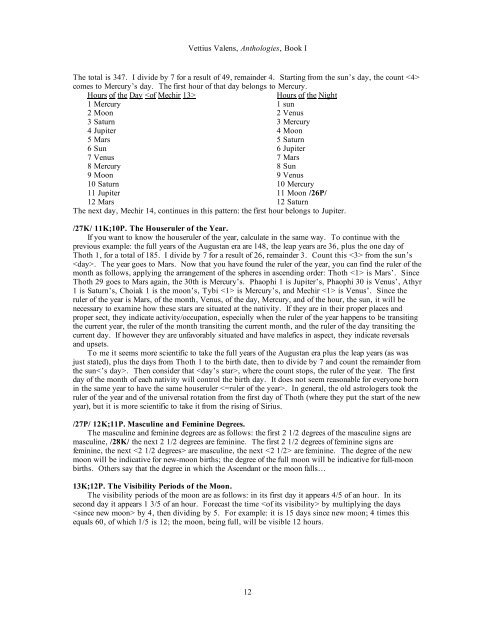Vettius Valens, Anthologies
Vettius Valens, Anthologies
Vettius Valens, Anthologies
You also want an ePaper? Increase the reach of your titles
YUMPU automatically turns print PDFs into web optimized ePapers that Google loves.
<strong>Vettius</strong> <strong>Valens</strong>, <strong>Anthologies</strong>, Book I<br />
The total is 347. I divide by 7 for a result of 49, remainder 4. Starting from the sun’s day, the count <br />
comes to Mercury’s day. The first hour of that day belongs to Mercury.<br />
Hours of the Day Hours of the Night<br />
1 Mercury 1 sun<br />
2 Moon 2 Venus<br />
3 Saturn 3 Mercury<br />
4 Jupiter 4 Moon<br />
5 Mars 5 Saturn<br />
6 Sun 6 Jupiter<br />
7 Venus 7 Mars<br />
8 Mercury 8 Sun<br />
9 Moon 9 Venus<br />
10 Saturn 10 Mercury<br />
11 Jupiter 11 Moon /26P/<br />
12 Mars 12 Saturn<br />
The next day, Mechir 14, continues in this pattern: the first hour belongs to Jupiter.<br />
/27K/ 11K;10P. The Houseruler of the Year.<br />
If you want to know the houseruler of the year, calculate in the same way. To continue with the<br />
previous example: the full years of the Augustan era are 148, the leap years are 36, plus the one day of<br />
Thoth 1, for a total of 185. I divide by 7 for a result of 26, remainder 3. Count this from the sun’s<br />
. The year goes to Mars. Now that you have found the ruler of the year, you can find the ruler of the<br />
month as follows, applying the arrangement of the spheres in ascending order: Thoth is Mars’. Since<br />
Thoth 29 goes to Mars again, the 30th is Mercury’s. Phaophi 1 is Jupiter’s, Phaophi 30 is Venus’, Athyr<br />
1 is Saturn’s, Choiak 1 is the moon’s, Tybi is Mercury’s, and Mechir is Venus’. Since the<br />
ruler of the year is Mars, of the month, Venus, of the day, Mercury, and of the hour, the sun, it will be<br />
necessary to examine how these stars are situated at the nativity. If they are in their proper places and<br />
proper sect, they indicate activity/occupation, especially when the ruler of the year happens to be transiting<br />
the current year, the ruler of the month transiting the current month, and the ruler of the day transiting the<br />
current day. If however they are unfavorably situated and have malefics in aspect, they indicate reversals<br />
and upsets.<br />
To me it seems more scientific to take the full years of the Augustan era plus the leap years (as was<br />
just stated), plus the days from Thoth 1 to the birth date, then to divide by 7 and count the remainder from<br />
the sun. Then consider that , where the count stops, the ruler of the year. The first<br />
day of the month of each nativity will control the birth day. It does not seem reasonable for everyone born<br />
in the same year to have the same houseruler . In general, the old astrologers took the<br />
ruler of the year and of the universal rotation from the first day of Thoth (where they put the start of the new<br />
year), but it is more scientific to take it from the rising of Sirius.<br />
/27P/ 12K;11P. Masculine and Feminine Degrees.<br />
The masculine and feminine degrees are as follows: the first 2 1/2 degrees of the masculine signs are<br />
masculine, /28K/ the next 2 1/2 degrees are feminine. The first 2 1/2 degrees of feminine signs are<br />
feminine, the next are masculine, the next are feminine. The degree of the new<br />
moon will be indicative for new-moon births; the degree of the full moon will be indicative for full-moon<br />
births. Others say that the degree in which the Ascendant or the moon falls…<br />
13K;12P. The Visibility Periods of the Moon.<br />
The visibility periods of the moon are as follows: in its first day it appears 4/5 of an hour. In its<br />
second day it appears 1 3/5 of an hour. Forecast the time by multiplying the days<br />
by 4, then dividing by 5. For example: it is 15 days since new moon; 4 times this<br />
equals 60, of which 1/5 is 12; the moon, being full, will be visible 12 hours.<br />
12

















